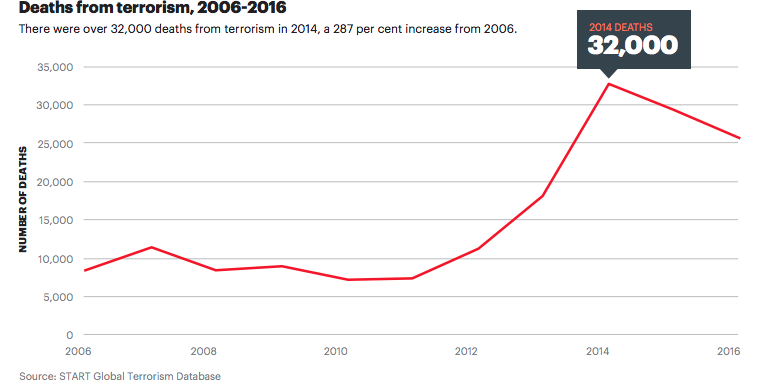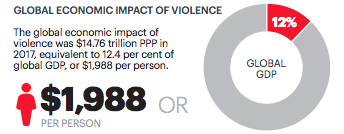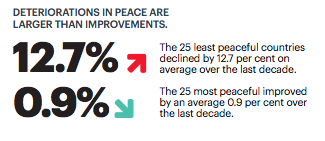The Global Peace Index revealed the cost of violence worldwide.
Violence has a direct effect on the way we live, and according to recent reports, its also deeply shakes the global economy.
According to the 12th edition of the annual Global Peace Index report, the world’s leading measure of global peacefulness, produced by the Institute for Economics and Peace (IEP), the economic impact of violence in 2017 was of $14.8 trillion dollars, or 12.4% of the global GDP (Gross Domestic Product), which makes it equivalent to nearly $2,000 per person.
As the world becomes less peaceful today than at any time during the last decade, the Institute for Economics and Peace also found that for the fourth year in a row, overall levels of peace around the world have deteriorated.
Even the most peaceful regions in the world according to the index – Europe, North America, Asia-Pacific, and South America – have all recorded declines.
Battle deaths and refugees, higher than ever
Among the key findings of the report, it is seen that the number of annual battle deaths has peaked by 264% over the last decade, making both Europe and North America less peaceful regions than they were last year.
Deaths due to conflict, democracy conflicts and political corrupt cases have shook peace efforts in the South American and Asia-Pacific region.
According to the UNHCR, there are now almost 70 million forcibly displaced people worldwide, around 1% of the world’s population – the highest number in modern history.
This number of refugees has steadily increased since 1951, but has seen a dramatic jump in the last 10 years, mostly because of the Syrian civil war that began in 2011.
The world’s most peaceful countries were:
Iceland (Score: 1.096)
New Zealand (Score: 1.192)
Austria (Score: 1.274)
Portugal (Score: 1.318)
Denmark (Score: 1.353)
Canada (Score: 1.372)


The study reveals the Middle East and North Africa remained the world’s least peaceful region in 2018.
North America retained its second-place regional ranking for the tenth year running, despite that the level of peacefulness in the U.S. declined for the second consecutive year, facing its worst level of any time since 2012.
Canada suffered a deterioration in its terrorism impact rating after attacks in Edmonton and Quebec.
Russia and Eurasia remained in seventh place despite a slight deterioration in the overall score. Three countries – Ukraine, the Kyrgyz Republic and Moldova – improved their scores while nine others deteriorated.
The biggest challenge to peace in Central America and the Caribbean is crime and corruption. For the last eight years, the region has had the worst scores in the index for homicide rate, violent crime, and perceptions of criminality.
Organized crime, predatory street gangs, transnational narcotrafficking, government corruption cases, protests and political instability have pinned Central America and the Caribbean, struggling to maintain its 4th spot in the global rankings.




The economic impact of violence has increased 16% since 2012, corresponding with the start of the Syrian war and rising violence in the aftermath of the Arab uprising in Libya, Yemen and other parts of the Middle East and North Africa.
Violence has both a direct and indirect impact on individuals and societies. The direct costs associated with violence are due to the immediate consequences of violence on the victims, perpetrators and public systems including health, judicial and public safety. The indirect costs of violence refer to the discounted long term costs such as lost productivity, psychological effects and the impact of violence on the perception of safety and security in a society.












